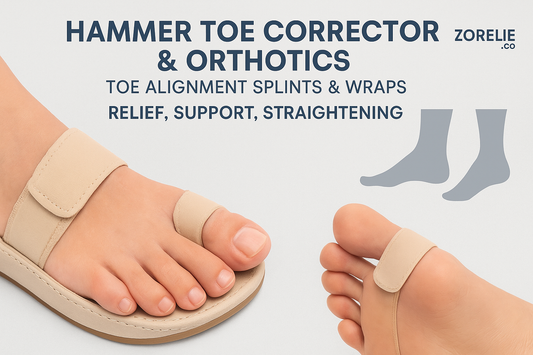Introduction
Hammer toe — when one or more of your smaller toes bends downward at the middle joint, resembling a hammer or claw — affects many people, causing discomfort, pain, difficulty walking, and trouble fitting into shoes. While severe or rigid hammer toes sometimes require surgical intervention, most cases benefit greatly from non-surgical correction aids, including splints, wraps, and orthotic devices.
If you're seeking relief, the Hammer Toe Corrector & Orthotics – Toe Alignment Splints & Wraps from Zorelie.co offers precisely what you need: gentle support, comfort, and gradual correction of hammertoe deformities—without surgery.
What Is a Hammer Toe & Why It Happens
A hammer toe is one of the most common toe deformities. Medically, it involves bending at the proximal interphalangeal (PIP) joint of the toe, causing the toe to arch upward in the middle while the end of the toe (distal portion) points downward. There are several subtypes: flexible hammer toes, semi-rigid, and rigid deformities. The cause can be multifactorial:
-
Wearing shoes that are too tight, have a narrow toe box, or high heels. Thông Tin Sinh Học Quốc Gia+1
-
Muscle imbalance in the toes and foot, causing certain tendons to overpower others. Thông Tin Sinh Học Quốc Gia+1
-
Trauma or injury.
-
Underlying conditions such as arthritis, diabetes, or nerve or vascular issues. Thông Tin Sinh Học Quốc Gia
Symptoms include pain, difficulty fitting shoes, corns or calluses due to rubbing, swelling, redness, and occasional stiffness. Left untreated, hammer toes can become rigid and fixed, which greatly reduces treatment options. Mayo Clinic+1
Non-Surgical Treatment Options
Before considering surgery, healthcare professionals typically recommend conservative methods. These include:
-
Selecting footwear with wider toe boxes and low heels. Mayo Clinic+1
-
Using toe separators, pads, or orthotic inserts to reduce pressure, reduce rubbing, and gently realign toes. Southernmost Foot & Ankle Specialists+2Vive Health+2
-
Stretching and strengthening toe muscles using simple exercises at home.
-
Splints or wraps to support the toes in correct alignment, especially during rest or sleep.
That’s where specialized devices like the Hammer Toe Corrector & Orthotics – Toe Alignment Splints & Wraps shine—they allow you to apply those non-surgical methods more consistently and comfortably.
Features & Benefits of Hammer Toe Corrector & Orthotics
Here are what you can expect from the Hammer Toe Corrector & Orthotics – Toe Alignment Splints & Wraps:
-
Gentle Toe Realignment
The splints or wraps are designed to gently straighten or realign bent toes over time. They help ease pressure on joints and restore a more natural toe position. -
Support & Pain Relief
Using a brace also reduces friction, pressure, and rubbing on shoes which often cause corns, blisters, and discomfort. With consistent wear, pain is reduced. -
Versatility & Comfort
The device should work whether you're walking, resting, or wearing shoes (depending on design). Soft materials, adjustable wraps, breathable fabric, and padded areas improve comfort. -
Prevent Progression
Early adoption helps prevent flexible hammer toes from becoming rigid ones. This can avoid the need for surgical correction. Medically recommended approach. Mayo Clinic+1 -
Improved Mobility & Confidence
Being able to wear shoes again comfortably, walk without pain, and perform daily tasks freely increases overall quality of life. -
Orthotic Component
Some designs include pads or metatarsal bands to hold the splint in position, preventing migration, enhancing stability. Performance Health
How to Use the Hammer Toe Corrector & Orthotics
Proper usage is key for effectiveness. Here's a guideline:
-
Initial Wear Time: Start with short intervals (30 minutes to 1 hour) each day. Increase gradually. Don’t force the toe into painful positions.
-
Wearing During Sleep: If the wrap or splint allows, wearing overnight can maintain alignment while the muscles relax.
-
Combining with Footwear Changes: Choose shoes with a wide toe box, low heel, and avoid pointed or tight tipped shoes. This supports the correction process.
-
Exercises: Toe stretches, picking up objects with toes, towel crunches, and dorsiflexion (lifting toes upward) help strengthen intrinsic muscles.
-
Care & Hygiene: Clean the splints/wraps regularly; ensure skin under straps or pads is clean and dry to prevent irritation.
Who Should Use It & When to See a Specialist
This product is ideal for:
-
People with mild to moderate hammer toes that are still flexible.
-
Those seeking relief from pain, pressure, or discomfort from toe deformities.
-
Individuals wanting a non-invasive, cost-effective approach before considering surgery.
You should see a healthcare professional if:
-
Toe deformity is rigid / fixed and cannot be passively straightened. Mayo Clinic
-
You have severe pain, ulcers, or risk of infection (especially if diabetic).
-
You notice numbness, severe swelling, bone exposure, or other alarming symptoms.
Why Choose Zorelie.co & This Product
When buying orthotics, splints, or corrective wraps, quality, design, comfort, and support matter. Zorelie.co offers:
-
High-quality materials & designs tested for comfort and effectiveness.
-
Attention to customer posture and foot health, including careful sizing, instructions, and support.
-
Reliable online shopping, secure checkout, returns/exchanges policies.
-
The Hammer Toe Corrector & Orthotics – Toe Alignment Splints & Wraps is one of their flagship foot health products, combining orthotic support & comfort.
What to Expect & Timeline
Results vary depending on:
-
Severity of the deformity (flexible vs semi-rigid vs rigid).
-
Consistency of use of the splint/wrap.
-
Footwear choices: switching to better fitting shoes speeds recovery.
-
Doing corrective exercises.
Typically, users start noticing reduced pain and improved feel within 2-4 weeks of regular wear (a few hours per day). Visible alignment improvement may take several weeks to a few months. For more severe cases, consulting with a foot specialist is recommended.
Comparing with Other Options
| Option | Pros | Cons |
|---|---|---|
| Hammer Toe Corrector & Orthotics (splints & wraps) | Non-surgical; adjustable; usually lower cost; low risk; you can wear at home/rest/night; helps prevent progression | Takes time; results vary; may cause temporary discomfort; not effective for rigid deformities without surgery |
| Surgery | Can provide more permanent correction; effective for rigid cases | Higher cost; recovery time; risks involved; sometimes loss of joint mobility; possible complications |
Given these comparisons, starting with a high quality splint/wrap like Zorelie’s product is often preferred by both patients & podiatrists for mild to moderate cases.
FAQs
Q: Can I wear the wrap with regular shoes?
A: Many designs allow wearing with shoes, especially those with wide toe boxes. Be sure to select shoes with enough space so the straps/splints do not press painfully.
Q: Is this product washable and reusable?
A: Yes—all Zorelie orthotics/splints & wraps are crafted for durability, with materials that can be cleaned and reused. Always follow care instructions to maintain comfort and hygiene.
Q: When will I see results?
A: Pain relief often happens fairly quickly (within a few days to a couple of weeks), while structural alignment improvements may require several weeks of regular use.
Q: Will this cure hammer toe permanently?
A: If the toe is still flexible, consistent use can significantly correct and prevent worsening. For rigid or long-standing deformities, surgical options may be necessary. But even in those cases, a brace/splint can help manage pain and slow progression.












